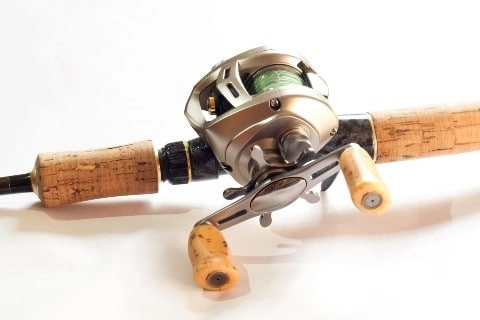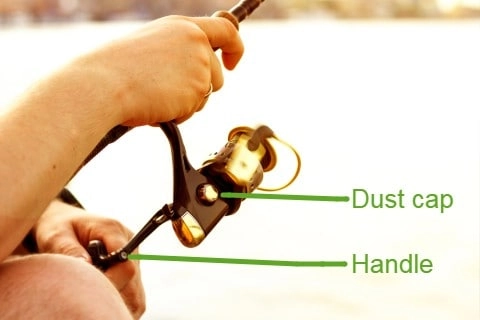Are you a left hander looking for a spinning reel to go fishing and can’t find one that feels comfortable to use? That’s probably because manufacturers don’t make them specifically for handedness but install the reel to suit right-handers by default. Fortunately, this is not something to worry about, as you can buy the rod you want and change the reel configuration to the other side if you want. In this article, we show you how to change a fishing reel from left to right handed retrieve, which is what most left-handers will be most comfortable with.
Table of Contents
What Side is the Handle on a Left Handed Reel?
When it comes to fishing with a spinning reel, most anglers will cast with their dominant hand and use the other hand to retrieve so that you avoid specific problems that can occur when you switch hands after casting. That’s why right handers usually crank with the handle on the left side, which is a left-handed reel, while left-handers prefer to use a right-handed spinning reel. We go into more detail about left-handed vs right-handed reels of these as well as baitcasters in a separate article.
Are Baitcaster Reels Reversible?

Baitcasting usually involves switching hands in the middle so that you cast as well as retrieve with your dominant hand. This means that, traditionally, baitcasters have the handle on the right side, making it difficult for left-handers to get used to this kind of fishing reel. The reason is that the parts of a baitcasting reel are not exposed and cannot be reversed. Fortunately, modern baitcasters are now available in both left- and right-handed configurations, so if you’re a lefty you can just buy the correct reel for your needs, which probably is a right-handed spinning reel.
Parts of a Spinning Reel
The parts of a spinning reel are exposed. Therefore, it’s easy to switch sides when you wish to use the hand you’re most comfortable to cast with or reel the lure or fish in with. However, before you begin the procedure, it’s best to understand the various parts of this equipment. Through this, you have a better understanding of how its components work together to release the line.
Reel Body
The reel body is the main component of the fishing rod. It features a support arm, a foot stem, and a gear box housing. Reel bodies are normally comprised of aluminum, which is strong and heavy, or graphite, which is much lighter. The latter material works better in salt water due to its natural anti-corrosion composition.
Reel Handle

This is a critical component of a fishing reel. It’s rotated by hand to return the line back to the spool after a cast. The handle is either round or in the shape of a T-bar and can be operated by the left or right hand. This depends on how it’s secured to the body (see below for moving instructions). It is secured to the reel body by a screw or a bolt going through an internal socket and protected by a dust cap on the opposite side.
Reel Spool
This component holds the fishing line secure. In normal operations, it allows for smooth release that goes the distance. The spools are normally made of aluminum or graphite, like the body of a fishing rod.
Drag Adjustment
The drag adjustment knob, which resembles a dial, is normally found on the top of the reel spool. It allows the angler to adjust the amount of friction the washers that connect the spool to the shaft exert to let out more line when a fish takes hold. When the drag isn’t properly set, you risk a break that could free the catch.
Bail
On a spinning reel, the bail acts as a gateway for the line. When it’s engaged, the line can’t unwind from the spool. When casting, the bail is open to release the line. Furthermore, it helps bring in the line when you want it to return to the reel.
Anti-Reverse Switch
Used to help bring in lighter fish, the anti-reverse switch engages the drag. In doing so, it prevents the spool from turning backward. When it’s deactivated, you rely on your strength to pull in a fish instead of utilizing the drag system to adjust the tension. Not all reels have this component.
Steps to Move the Fishing Reel From Left to Right
Before you begin the process of moving the fishing reel crank from left to right, look at its setup. It has a similar design to bike pedals. However, it only has one handle instead of two. Think of this as you follow the procedures.
- Begin to unscrew the cap on the opposite side of the handle. As you do this you’ll notice the reel handle becomes loose. The reason is the cap works as a bolt connector between the two parts. Some dust caps don’t have a bolt attached and only protect the end of the screw from the handle. In those cases, the socket for the handle’s screw is inside the reel body.
- Keep on turning the cap until it comes off to reveal a set of mini-ball bearings. When this happens, the handle comes off.
- Clean and lubricate these parts of the reel. This increases the chances of a smooth cast that goes farther, especially for salt water fishing where corrosion happens faster.
- Take the handle and insert it on the other side of the rod and fix the dust cap on the opposite side too.
- If the cap has a bolt connector, screw the cap back on until it’s tight. If the handle screws into an internal connector then turn the handle until it’s tight. Don’t use tools or over-tighten.
